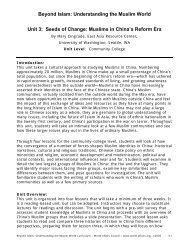The Japanese Approach to Environmental Issues - World Affairs ...
The Japanese Approach to Environmental Issues - World Affairs ...
The Japanese Approach to Environmental Issues - World Affairs ...
You also want an ePaper? Increase the reach of your titles
YUMPU automatically turns print PDFs into web optimized ePapers that Google loves.
Local <strong>Japanese</strong> GardensTHE JAPANESE GARDEN IN THE WASHINGTON PARK ARBORETUMhttp://www.ci.seattle.wa.us/parks/parkspaces/japanesegarden.htm#aboutLocated within the Washing<strong>to</strong>n Park Arboretum, this is a three and a half-acre formal gardendesigned and constructed under the supervision of world-renowned <strong>Japanese</strong> garden designer JukiIida in 1960. Chado (<strong>The</strong> Way of Tea) demonstrations are offered periodically. For more informationon tea demonstrations, view the Urasenke Foundation's events page at:http://www.urasenkeseattle.org/page21.KUBOTA GARDENhttp://www.seattle.gov/parks/park_detail.asp?ID=415Hidden in South Seattle, Kubota Gardens is a stunning twenty-acre landscape that blends <strong>Japanese</strong>garden concepts with native Northwest plants. <strong>The</strong> city acquired the property, which is an his<strong>to</strong>riclandmark, in 1987 from the estate of master landscaper Fujitaro Kubota. Kubota was a horticulturalpioneer when he began merging <strong>Japanese</strong> design techniques with North American materials in hisdisplay garden in 1927. <strong>The</strong> Gardens are a spectacular setting of hills and valleys, interlaced withstreams, waterfalls, ponds, bridges, and rock out-croppings with a rich array of plant material.JAPANESE REMEMBRANCE GARDEN AT SEATTLE UNIVERSITYhttp://www.seattleu.edu/home/news_events/news/news_detail.asp?elID=3212006105718&elYear=2006Located on the northeast corner of the Seattle University campus that once was the site of a<strong>Japanese</strong>-American community, the <strong>Japanese</strong> American Remembrance Garden serves as a livingmemorial <strong>to</strong> <strong>Japanese</strong> Americans who were forced <strong>to</strong> live in internment camps during <strong>World</strong> War II.Seattle University established the garden as a special area for healing, reflection, and inspiration. Italso celebrates the legacy of Fujitaro Kubota, a <strong>Japanese</strong> immigrant who was interned at CampMinidoka in Idaho. After the war, Kubota designed nine gardens at Seattle University. His grandson,Allan Kubota, is the master landscaper of the <strong>Japanese</strong> American Remembrance Garden, the tenthKubota garden on campus. <strong>The</strong> garden features plants, trees and rocks, all carefully positioned <strong>to</strong>create the balance and simplicity that are distinctive of <strong>Japanese</strong> gardens.JAPANESE GARDEN AND BRIDGE, EVERETT COMMUNITY COLLEGEhttp://www.everettcc.edu/programs/socsci/nbi/index.cfm?id=5040&linkFrom=SearchFollowing traditional <strong>Japanese</strong> design standards, the garden provides a local example of <strong>Japanese</strong>design and gardening. <strong>The</strong> garden landscape includes several classical <strong>Japanese</strong> garden elementsincluding a formal entry gate, waterfall and stream, tea garden, rock garden, tsubo garden, s<strong>to</strong>nebridge, earthen bridge, and wooden bridge; it is enclosed by a tiled roof and earthen wall. <strong>The</strong> gardenprovides a formal entryway <strong>to</strong> the NBI Center, a retreat from everyday activities, and a place <strong>to</strong> learnmore about <strong>Japanese</strong> culture and art forms.FILMSSPICE: USING FILM TO EXPLORE HISTORYhttp://spice.stanford.edu/docs/using_film_<strong>to</strong>_explore_his<strong>to</strong>ry/Film's ability <strong>to</strong> serve up living images of past events gives it an advantage over most his<strong>to</strong>ry books.Most feature films invite their viewers <strong>to</strong> identify with the characters and scenes depicted on screen;watching Akira Kurosawa 's Seven Samurai (1954) leaves one with a visceral and nearly indelible senseof what a <strong>Japanese</strong> village must have looked like, and a feeling as well for some of the ideas aboutstatus that came <strong>to</strong> structure early modern Japan.28











